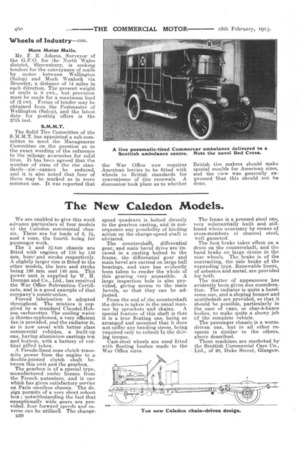The New Caledon Models.
Page 12

If you've noticed an error in this article please click here to report it so we can fix it.
We are enabled to give this week advance particulars of four models of the Caledon commercial chassis. These are for loads of 3, 34, and 4 tons, the fourth being for passenger work.
The 3 and 31-ton chassis are fitted with engines of 110 by 140 mm. bore' and stroke respectively. A slightly larger size is fitted to the other models, the bore and stroke being 120 mm. and 140 mm. This power unit is supplied by W. H. Dorman and Co., Ltd., has received the War Office Subvention Certificate, and is a good example of that company's construction.
Forced lubrication is adopted throughout. The mixture is an
by a standard Claudel-liobson carburetter. The cooling water is thernao-syphoned, a very efficient fan is provided, and the radiator is, as is now usual with better class commercial vehicles, a built-up one, having aluminium castings top and bottom, with a battery of vertical gilled tubes.
A Ferodo-lined cone clutch transmits power from the engine to a double-jointed clutch shaft between this unit and the gearbox.
The gearbox is of a special type, manufactured under licence from the French patentees, and is one which has given satisfactory service on Paris omnibus chassis. The de. sign permits of a very short robust box ; notwithstanding the fact that exceptionally wide gears are provided, four forward speeds and reverse can be utilized. The change n30 speed 'quadrant is bolted directly to the gearbox casting, and in consequence any possibility of binding action on the change-speed shaft is obviated.
The countershaft, differential gear; and main bevel drive are-encased in a casting bolted to the frame, the differential gear and main bevel are carried on large ball bearings, and care has evidently been taken to render the whole of this Rearing very accessible. A large inspection hole is also provided, giving access to the main bevels, so that they can be adjusted.
From the end of the countershaft the drive is taken in the usual manner by sprockets and chains. A special feature of this shaft is that it is a true floating one, being so arranged and mounted that it does not suffer any bending stress, being required only to submit to the driving torque.
Cast-steel wheels are used fitted with floating. bushes made to the War Office saes.
The frame is a pressed steel one, very substantially built and stiffened where necessary by means of cross-members of channel steel, well gusseted. The foot brake takes effect on a drum on the countershaft, and the hand brake on large drums in the rear wheels. The brake is of the contracting, the side brake of the expanding type. Renewable liners, of asbestos and metal, are provided for both.
The matter of appearance has evidently been given due consideration. The radiator is quite a handsome one, and a sloping bonnet and scuttleclash are provided, so that it should be possible, particularly in the case of vans, or char-k-bancs bodies, to make quite a showy job of the complete vehicle. The passenger chassis is a wormdriven one, but in all other respects is similar to the others. above described.
These machines are marketed by the Scottish Commercial Cars Co., Ltd., of 98, Duke Street, Glasgow.




















